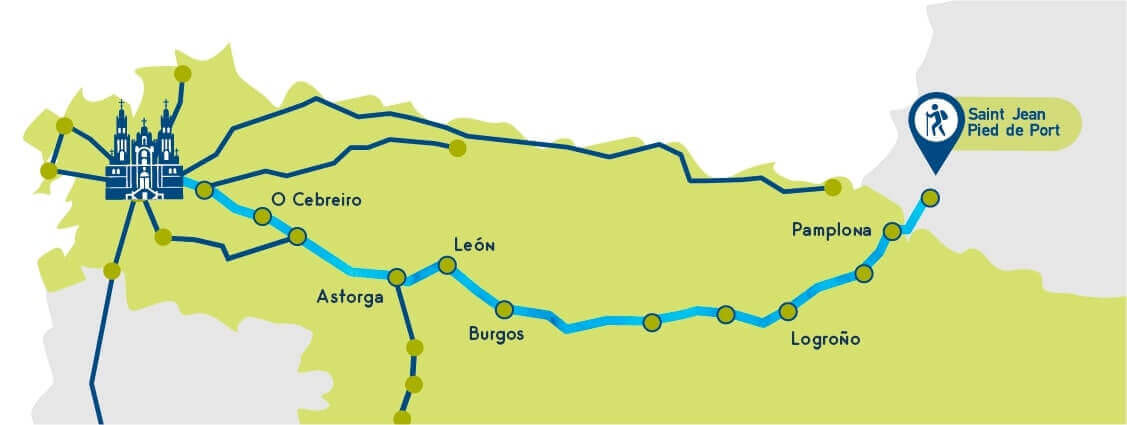Embarking on Camino de Santiago
Why I'm walking through the north of Spain for 30+ days and what I'm trying to gain from the experience
A Bit of History: The Camino de Santiago
The Camino de Santiago, also known as the Way of St. James, is a network of pilgrimage routes that lead to the Cathedral of Santiago de Compostela in Galicia, Spain. The cathedral is believed to house the remains of St. James the Apostle, one of Jesus’ closest disciples.
Origin
The origins of the pilgrimage date back to the early 9th century when the tomb of St. James was reportedly discovered in Santiago de Compostela. Over time, the Camino became one of the most important Christian pilgrimages, along with routes to Jerusalem and Rome. Pilgrims from across Europe traveled to Santiago, seeking penance, spiritual growth, and indulgences.
Decline and Revival
The pilgrimage experienced a decline during the Reformation and the Enlightenment, as religious fervor waned. However, in the 20th century, there was a revival of interest in the Camino, thanks in part to renewed religious devotion, the efforts of the Spanish government to promote it as a cultural heritage, and the designation of the Camino as a UNESCO World Heritage Site.
Today, the Camino is walked not only by religious pilgrims but also by those seeking personal growth, adventure, and a connection with history and culture.
The Camino Frances (the route I’m taking)
The Camino Frances, the most popular and well-known route, stretches approximately 500 miles from Saint-Jean-Pied-de-Port in France to Santiago de Compostela. It crosses the Pyrenees, traverses the plains of northern Spain, and passes through historic towns and cities, each with its own rich history and cultural significance.
Why People Do the Camino de Santiago
Spiritual and Personal Growth: Many people walk the Camino to seek spiritual enlightenment or personal growth. For some, it's a religious pilgrimage, while for others, it's a way to connect with themselves on a deeper level. Walking long distances provides a meditative experience that helps to clear the mind and focus on personal goals and reflections.
Physical and Mental Challenge: The Camino Frances, which is about 500 miles long, is a significant physical challenge. Completing it can be a testament to ones resilience and determination. People of all ages, fitness levels, and life stages embark on this journey, proving that it’s not just a physical challenge but also a mental and emotional one.
Connection with Others: The Camino offers a unique opportunity to meet people from all over the world, each with their own stories and reasons for walking. The shared experience fosters deep connections, and the wisdom and advice exchanged along the way can be life-changing. People of all ages and life phases traverse through northern Spain. It allows for connections that are different from your normal day-to-day or backpacking experiences.
Time for Reflection: The simplicity of life on the Camino—walking, eating, resting—allows for uninterrupted time to think and reflect. For many, this is a chance to step away from the distractions of everyday life and focus on what truly matters. It’s an opportunity to live in the moment and be fully present.
A Sense of Accomplishment: Completing the Camino is an achievement that stays with you. For some, it's about ticking off a bucket list item, while for others, it's about proving to themselves that they can accomplish something difficult. And for people like me, it’s hoping to find meaning at the end.
Why I Am Doing the Camino
A Long-Awaited Goal: Completing the Camino Frances has been on my bucket list for a long time, much like other challenging trips such as hiking the John Muir Trail (JMT). This journey comes at a pivotal moment in my life, and I believe it will bring the enlightenment I’m seeking. Since the Camino takes over a month to complete, it’s hard to find the time with work to do it so now feels like the right time.
Self-Discovery and Growth: I’m doing the Camino at a crossroads in my life, having left my tech job to travel and figure out my next steps. I see this journey as an opportunity to reflect deeply on my future, seek advice and wisdom from fellow pilgrims, and accomplish something meaningful.
Being Present and Connecting: I want to disconnect from the distractions of electronics, focusing instead on being fully present in the experience. I plan to connect with people from all walks of life, learning from their stories. However, I will try to document my journey through reels/TikToks each day.
Clarity for the Future: During the Camino, I intend to think seriously about where I want to live next, what job or business I want to pursue, and how to achieve these goals. I’m open to new realizations and ready to go with the flow, understanding that the journey might lead to unexpected insights.
Excitement and Openness: I’m excited about this journey, embracing the fact that it’s not heavily planned. I’m ready to take each day as it comes, fully open to whatever the Camino might bring. It will be fairly different from how I normally travel where I have a good idea of what my plans are. I’m planning my route and booking my accommodation the night before or morning of to allow for ample flexibility.
How to Follow Along
I will be embarking on the 500 mile journey from September 11 to October 14, averaging around 15-20 miles a day, starting in Saint-Jean-Pied-de-Port in France to Santiago de Compostela in Spain.
If you would like to follow along on my journey, I will try to post daily updates on my instagram @findingchi_ and tiktok @findingchi. And of course, I will write a full recap here when it’s all over.






